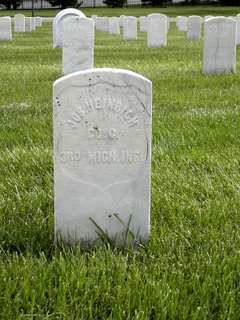 Based on present research and analysis, from mid-June of 1861 to mid-June of 1864, 232 men died while serving in the Third Michigan: 103 men were killed in action and 47 died from their wounds, while 80 died of disease, 2 died accidentally and 1 was murdered.
Based on present research and analysis, from mid-June of 1861 to mid-June of 1864, 232 men died while serving in the Third Michigan: 103 men were killed in action and 47 died from their wounds, while 80 died of disease, 2 died accidentally and 1 was murdered.This represents a 16% casualty rate (based on a total enrolled of 1,411). (photo: Joseph Heinrich, Dayton National Cemetery; source: Steve Soper.)
While figures are still incomplete, on a company-by-company basis we note the following mortality rates:
A company suffered 21 deaths
B 19
C 20
D 17
E 19
F 19
G 26
H 23
I 28
K set the record with 33 deaths
Band 0
Field and Staff 2
When we take into account the men who were transferred to other regiments or who were discharged from the Third Michigan and reenetered the military, some 346 men did not survive the war.
As a group then the Third Michigan suffered a 24% casualty rate.
In other words, one of every four men who enrolled in the Third during the war would not survive.
The first man to die in the regiment was probably Joseph Proper or Propier, on May 8, 1861, at Cantonment Anderson in Grand Rapids, and he was buried about one mile away in what is now Oak Hill (north) cemetery, at the corner of Eastern and Hall streets in Grand Rapids.
The first man to die after the regiment arrived in Virginia was William Choates of C company, and he died of disease at Camp Blair, Virginia.
Homer Morgan of B company was the first to die by violence, on July 20, 1861, allegedly a suicide.
The first man to be killed in action was David Stone of H company, who was shot on May 5, 1862, near Yorktown, Virginia.
It is somewhat harder to identify the last man to die during the war. Moses Monroe, originally of Company E and transferred to the Fifth Michigan Infantry in June of 1864, was wounded on April 6, 1865 at Sayler’s Creek, Virginia, near Appomattox and died of his wounds on April 23. However, 14 other former members of the Third Michigan died in April of 1865, and another 4 in May.
For example, Casper Thenner, sick from disease, had just returned to his home in Grand Rapids when he died on May 27, and was interred in what is now an unmarked grave in Oak Hill (south) cemetery.
The last to die in 1865 was probably Joel Guild, who had recently returned to his home in Grand Rapids and was suffering from dysentery contracted in the service, when he died in December.
Perhaps the last man to die as a direct consequence of the war was Samuel Thurston of C company. According to the Grand Rapids Herald of February 9, 1897, “After carrying a rebel bullet in his right lung for over thirty years” Thurston, who was an inmate of the Michigan Soldiers' Home “has given up the fight. The bullet had for over thirty years been ploughing its way downward through the tissues of the lungs, and yesterday afternoon dropped out, death being almost instantaneous. The ball was covered with a linen patch, just as it had left the rifle of some rebel soldier, the patch and bullet being firmly connected. At 2 o'clock yesterday morning Thurston was taken to the hospital, having been in usual good health up to a short time before that. In the afternoon he complained to his nurse that his heart pained him, and while she was gone to secure a hot water application Thurston died.” (photo: Michigan Soldiers' Home cemetery, Grand Rapids; source: Steve Soper.)
The last known survivor of the Third Michigan was Willard Olds of Company C who died at his home near Belding, Ionia county in 1937 and was buried in Otisco cemetery.
Next: prisoners of war
No comments:
Post a Comment